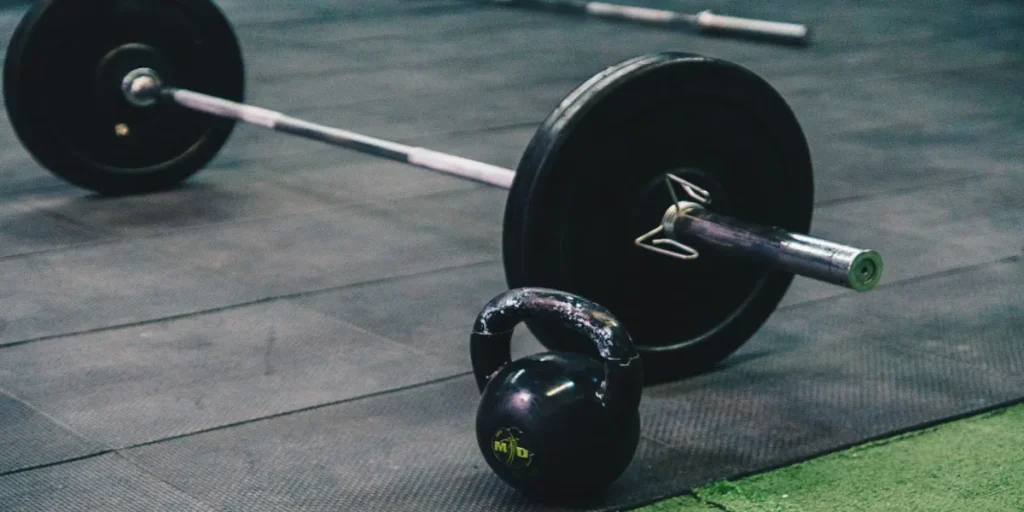A standard Olympic barbell weighs 20 kilograms (44 pounds). The weight can vary, as women’s Olympic bars typically weigh 15 kg (33 pounds).
When starting in weightlifting, understanding the equipment used is crucial. A barbell is among the most fundamental pieces of gear.
Outside of the Olympic standards, barbells can come in numerous sizes and weights, designed for different lifts and skill levels.
For instance, a standard bar found in home gyms usually weighs around 13 to 18 kilograms (28 to 40 pounds).
The bar’s weight is an essential consideration during training, as it contributes to the overall load lifted.
Beginner or junior lifters might use lighter bars as they develop their technique and increase their strength.
Identifying the weight of your barbell helps in tracking progress and ensuring proper workout adjustments.
Whether you’re an aspiring powerlifter, bodybuilder, or a fitness enthusiast, selecting the right barbell is a pivotal step in your strength training journey.

Decoding Barbell Basics
Understanding the weight and structure helps in workouts.
Let’s break down barbell fundamentals for gym enthusiasts.
The Anatomy Of A Barbell
A barbell has several key parts. The shaft is the long, central part you hold. The sleeves are at the ends and hold weights.
The knurling on the shaft improves grip. Additionally, collars secure weights in place.
Barbell Types And Their General Weights
Different types of barbells vary in weight.
Here’s a quick overview:
| Type | Weight |
|---|---|
| Standard | 20 pounds (9 kg) |
| Olympic | 45 pounds (20 kg) |
| Women’s Olympic | 33 pounds (15 kg) |
| Easy Curl | 15 pounds (7 kg) |
Standard barbells are lighter, good for beginners. Olympic barbells are heavier, used in competitions.
Women’s Olympic barbells are lighter and shorter than men’s. Easy curl barbells have grips for bicep and tricep workouts.
Standard Vs Olympic Barbells

Choosing the right barbell is a key decision for any weightlifter. Two popular options are Standard and Olympic barbells.
Each type serves different needs and comes with its own set of features. Let’s dive into the dimensional differences and weight capacities to help you pick the ideal barbell.
Dimensional Differences
Olympic barbells stand out with their standardized length and diameter. They typically measure about 7 feet (2.2 meters) in length and weigh around 20 kilograms (44 pounds).
The sleeve diameter is 50 millimeters, fitting Olympic weight plates snugly.
In contrast, Standard barbells are less uniform in size. They generally weigh 13 to 18 kilograms (28 to 40 pounds) and are shorter, around 5 to 6 feet (1.5 to 1.8 meters).
Their sleeve diameter is usually 25 millimeters, made for standard plates.
Weight Capacities And Uses
Olympic barbells can handle heavier weights, often up to 750 kilograms (1650 pounds).
This makes them perfect for heavy lifting and professional training. Their design also includes rotating sleeves, which reduce torque on the wrists and forearms during lifts.
Standard barbells have a lower weight capacity, suitable for home gyms and lighter workouts. They’re great for beginners and offer an affordable option for those starting out.
Surprising Weight Variations
Think all barbells weigh the same? Think again! Barbells come in a range of weights, sparking curiosity among fitness enthusiasts.
The standard image of a barbell—sleek and metallic—often hides the surprising weight variations that exist.
Let’s dive into the factors that affect a barbell’s weight and explore some unique barbells with weights you might not expect.
Factors Affecting The Weight Of Barbells
Several factors can influence the weight of a barbell, making each one unique:
- Material: The type of metal used can increase or decrease weight.
- Length: Longer barbells typically weigh more.
- Diameter: Thicker bars often equal heavier weights.
- Collars: Fixed or rotating, collars add to the overall weight.
- Brand: Different manufacturers have their own standard weights.
Uncommon Barbells And Their Unique Weights
Step aside, standard barbells; here are some uncommon ones:
| Type of Barbell | Weight |
|---|---|
| Aluminum Technique Bars | 15 lbs |
| Women’s Olympic Bars | 33 lbs |
| Men’s Olympic Bars | 44 lbs |
| Strongman “Apollon’s Axle” | Up to 74 lbs |
These barbells cater to different training needs, from learning proper form with the lightweight Technique Bars to testing your might with the massive “Apollon’s Axle.”
Measuring The Weight Of Your Barbell

Knowing the weight of your barbell is crucial for weight training. It helps you track progress and ensures you lift safely. Let’s explore how to measure your barbell’s weight accurately.
Tools For Accurate Weighing
For precise measurements, specific tools are essential. Here are popular options:
- Digital Scales: Offer exact weight readings.
- Traditional Scales: Good for a rough estimate.
- Calibration Weights: Confirm scale accuracy.
Common Mistakes In Measuring Barbell Weight
Avoid these errors to ensure a correct measurement:
- Ignoring the Calibration: Always verify your scale’s precision.
- Uneven Surfaces: Place scales on flat, stable ground.
- Inaccurate Scales: Check for defects or battery issues.
Impact Of Barbell Weight On Training
The weight of a barbell significantly impacts your workout routine.
Whether you’re a beginner or seasoned athlete, understanding this effect tailors your strength training effectively. Let’s dive into how barbell weight shapes your fitness journey.
Adjusting Workouts For Barbell Weight
Matching barbell weight to your skill level matters. Your muscles need to lift the right weight to grow. Not too heavy; not too light. Here’s how to adjust:
- Beginners should start light: Mastering technique comes first. Lighter barbells allow for this.
- Progress slowly: Add weight in small increments. This approach builds strength safely.
- Switch up routines with weight variations: Different exercises call for different barbell weights. Adapt as needed.
Influence On Lifting Form And Safety
Lifting form is everything. A heavy barbell can compromise safety and form. Keep these tips in mind:
- Maintain control: Control the barbell at all times to engage the correct muscles.
- Spotter assistance: A spotter can help you manage heavier weights.
- Avoid overloading: Lifting too much can lead to injury. Recognize your limits.
Correct posture and technique prevent injuries. They ensure you get the most from your workout. Choose a barbell weight that allows you to maintain proper form throughout your set.
Buying Guide For Barbells
Welcome to the ultimate Buying Guide for Barbells! Whether you’re a beginner or a seasoned athlete, selecting the right barbell is crucial.
Identifying The Right Barbell Weight For You
Choosing the correct barbell weight is vital for your training progress. It depends on various factors, including your strength level, the types of exercises you plan to do, and your fitness goals.
Standard barbells typically weigh 20 kilograms (44 pounds), but they vary. Women’s barbells generally weigh 15 kilograms (33 pounds), and junior barbells are lighter, around 10 kilograms (22 pounds).
To identify the proper weight:
- Start with your current fitness level.
- Consider the exercises you’ll perform.
- Think about your long-term workout goals.
Always opt for a barbell that allows you to maintain proper form while still challenging your muscles.
Top Considerations When Purchasing A Barbell
When in the market for a barbell, there are several key factors to keep in mind:
- Barbell Type: Olympic, powerlifting, or standard – which suits your needs?
- Weight Capacity: Ensure the barbell can handle the maximum load you’ll lift.
- Bar Length: Check that the bar fits your available space and grip width.
- Material and Finish: High-quality steel with a rust-resistant finish is ideal.
- Knurling: Comfortable grip is crucial; a knurled pattern aids in preventing slippage.
| Type of Lifter | Recommended Barbell Weight |
|---|---|
| Beginner | 10-15 kg (22-33 lbs) |
| Intermediate | 15-20 kg (33-44 lbs) |
| Advanced | 20+ kg (44+ lbs) |
Remember, a quality barbell is an investment in your fitness journey. Prioritize durability, functionality, and comfort to find a barbell that will support your training for years to come.
FAQs About the Weight of a Barbell
What Is The Standard Weight Of A Barbell?
A standard Olympic barbell weighs about 20 kilograms or 44 pounds. It’s the typical choice for strength training in gyms and competitions.
How Much Does An Ez Curl Bar Weigh?
An EZ curl bar typically weighs between 10 to 15 pounds (4. 5 to 6. 8 kilograms). Its lighter weight makes it a popular option for arm exercises.
Can A Barbell’s Weight Vary By Type?
Yes, barbell weights can vary significantly. For example, a standard Olympic barbell weighs 44 pounds, whereas a women’s barbell might weigh 33 pounds, and a technique bar can be around 15 pounds.
What Is The Weight Of A Women’s Olympic Barbell?
A women’s Olympic barbell weighs approximately 15 kilograms or 33 pounds. It’s slightly shorter and lighter than the men’s version, catering to women’s Olympic weightlifting events.
Conclusion
Wrapping up, barbell weights vary widely, suited for every fitness level. From the standard 45-pound Olympic bar to lighter practice options, there’s a match for you.
Your workout goals dictate the choice. Remember, proper form trumps heavy loads every time.
Stay safe and lift smart!
